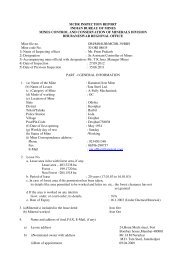Market Survey on Copper - Indian Bureau of Mines
Market Survey on Copper - Indian Bureau of Mines
Market Survey on Copper - Indian Bureau of Mines
Create successful ePaper yourself
Turn your PDF publications into a flip-book with our unique Google optimized e-Paper software.
viscosity <strong>of</strong> slag during smelting affecting matte-slag separati<strong>on</strong> leading to<br />
increased copper losses in slag.<br />
Roasting is generally performed employing multiple hearth <strong>of</strong> fluid bed<br />
roasters. Fluid bed roasters are preferred because <strong>of</strong> their high producti<strong>on</strong> rates,<br />
excellent temperature and chemical c<strong>on</strong>trol and high SO2 c<strong>on</strong>centrati<strong>on</strong> in<br />
effluent gases.<br />
iii) Matte Smelting : Smelting or matte smelting c<strong>on</strong>sists <strong>of</strong> melting<br />
c<strong>on</strong>centrates or partially roasted c<strong>on</strong>centrates at 1,150 - 1,200 o C to produce the<br />
separable liquid phases known as copper matte (Cu 30-60% sp, gravity > 5) and<br />
slag (sp. gravity < 3). The matte (Cu2S, FeS) form feed for producti<strong>on</strong> <strong>of</strong><br />
blister copper. The slag are formed from the oxides in furnace charge<br />
(impurities in the c<strong>on</strong>centrate: SiO2, Al2O3, CaO, MgO and oxides from fluxing<br />
material) and ir<strong>on</strong> oxides produced by oxidati<strong>on</strong> during smelting. Smelting slag<br />
generally c<strong>on</strong>tains 30-40% ir<strong>on</strong> oxides (FeO, Fe2O3), 35-40% SiO2, 0-10%<br />
Al2O3 and 0-10% CaO.<br />
The reacti<strong>on</strong> between cuprous oxide (Cu2O) and ir<strong>on</strong> sulphide to<br />
produce copper sulphide (Cu2S) proceeds rapidly and fully as sulphur has<br />
greater affinity for copper than ir<strong>on</strong>. This is the main smelting reacti<strong>on</strong> and this<br />
is the reas<strong>on</strong> why copper is c<strong>on</strong>centrated in matte and ir<strong>on</strong> is partially slagged<br />
<strong>of</strong>f.<br />
Smelting operati<strong>on</strong>s are carried out in blast, reverberatory, electric and<br />
flash furnaces. As blast furnace requires lumpy feed, fine flotati<strong>on</strong> c<strong>on</strong>centrates<br />
are smelted in the other three furnaces <strong>on</strong>ly.<br />
iv) Reverberatory Smelting : The reverberatory furnace is the most widely<br />
used unit for matte smelting. It is a fuel fired hearth furnace in which<br />
c<strong>on</strong>centrates or roaster calcines are melted in presence <strong>of</strong> flux to produce<br />
separate layers <strong>of</strong> molten matte and slag. The heat for smelting is provided by<br />
burning fuel in the furnace and by passing hot combusti<strong>on</strong> gases over the<br />
charge. All types <strong>of</strong> material (lumpy or fine, wet or dry) can be readily smelted.<br />
However, everything is not well with the reverberatory furnace. It requires<br />
large quantity <strong>of</strong> hydrocarb<strong>on</strong> fuel because it makes little use <strong>of</strong> the energy<br />
which is potentially available from sulphide oxidati<strong>on</strong>. Thermal efficiency is in<br />
the range <strong>of</strong> 25 - 30% <strong>on</strong>ly. The reverberatory furnace gas presents serious<br />
polluti<strong>on</strong> problem because SO2 c<strong>on</strong>centrati<strong>on</strong> is too low (0.5 to 1.5% SO2) to<br />
form a feed for sulphuric acid manufacture, the minimum SO2 c<strong>on</strong>centrati<strong>on</strong><br />
required is 5%. The principal products from reverberatory furnace are liquid<br />
matte (30-50% Cu; 1150 o C), which collects gold and silver, is sent forward for<br />
c<strong>on</strong>verting and a liquid slag (0.3 to 0.8% Cu: 1200 o C) which is discarded as<br />
effluent gas (1250 o C).<br />
v) Electric Furnace Smelting : In the regi<strong>on</strong>s where abundant electricity is<br />
available at low price and fossil fuels are costly, electric furnaces are frequently<br />
used in place <strong>of</strong> reverberatory furnace for copper smelting. The advantages <strong>of</strong><br />
electric furnace smelting are:<br />
38
















